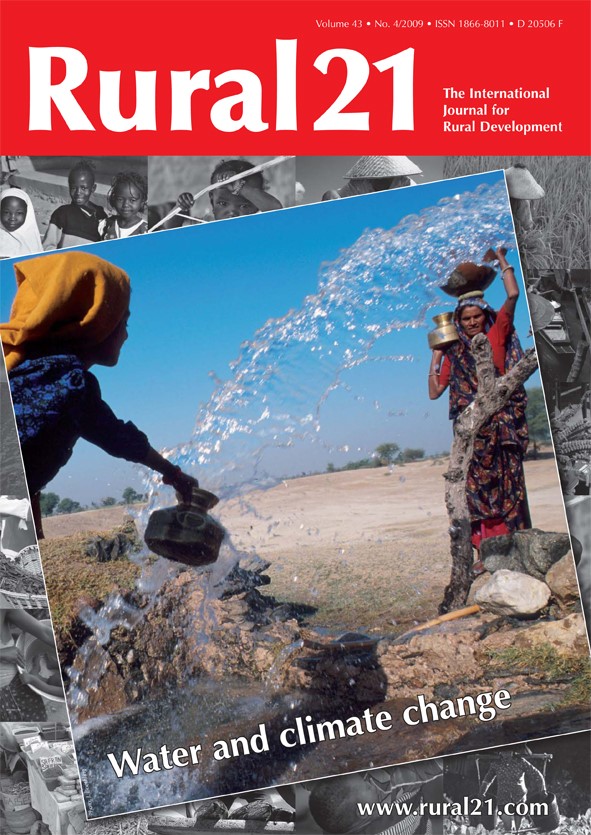Location
The international journal Rural 21 has dedicated more than 40 years to all topics surrounding rural development. Its ambition is to further those strategies and policies that strengthen rural areas of developing and newly industrialising countries and encourage their implementation. The journal addresses the complete range of relevant themes – from agriculture and fisheries via capacity building and education through to health and social security, energy supply and trade. Center-stage is always devoted to inquiring into how measures and strategies can contribute to global food security and to reducing poverty.
Rural 21 desires to further the dialogue between science and politics, the private sector, civil society and practitioners. Two platforms are designed for this purpose: Rural 21 in print is published four times a year, each issue highlighting a specific focus of rural development – this print edition is read in more than 150 countries. In parallel, Rural 21 online keeps the rural development community up to date on news and events, scientific findings and other print and online publications.
Rural 21 is published by DLG-Verlag GmbH in Frankfurt/Germany. Financial partners are BMZ (German Federal Ministry for Economic Cooperation and Development), GIZ (Deutsche Gesellschaft für Internationale Zusammenarbeit), DLG (German Agricultural Society – Deutsche Landwirtschaft-Gesellschaft), SDC (Swiss Agency for Development and Cooperation) and Helvetas Swiss Intercooperation.
The first issue of Rural 21 dates back to 1968. From 1974 to 2007, the journal was published in three languages entitled "entwicklung & ländlicher raum" / "agriculture & rural development" / "agriculture & développement rural". In 2008, the journal was relaunched as "Rural 21".
Members:
Resources
Displaying 246 - 250 of 319Impact of climate change on the Nile river basin
The River Nile provides an invaluable source of livelihoods to over 160 million of people who dwell in its valley. The river valley is renowned for being a cradle of civilisation. As the populations grew and civilisation evolved, the demand for more water resources took a toll in the region. The more recent visible climate change effects have further compounded water management in the basin. Water and food security in the region is under threat, hence the need for robust transboundary water management. An effective institutional arrangement is a key factor in facilitating this process.
Foreign direct investments in land in developing countries
The world food crisis has spurred foreign direct investments (FDI) into arable land in developing countries. While significant financial inflows into agricultural sectors could be beneficial on a global scale, it could negatively affect local livelihoods. This article provides an overview of the different types of FDI in land. In addition, examples of investment flows are illustrated in an overview and a sustainable impact matrix outlines the occurring effects. Finally, requirements of avoiding negative effects are presented, to achieve a Pareto-efficient win-win situation.
Impact of melting glaciers in the Himalaya
The Himalayan region is not only tectonically active and ecologically fragile but is it also one of the most economically underdeveloped and most densely populated mountain ecosystems on the planet. These natural as well as human characteristics render the Himalayan region highly vulnerable to the impacts of development, degradation and climate change and in particular the impact of melting of glaciers and changes in the patterns of precipitation.
How do small farmers respond to climate change in Rajasthan?
Water is scarce in India's semiarid zones of Rajasthan. Climate change is putting additional pressure on the rare resources. Irregular or no rainfall forces many small farmers to abandon their fields, at least temporarily, and seek work in the towns. Participative water management projects as practiced in Bhipur village, growing crops with low water requirements and more sustainable farming practices are adaptation strategies that allow farmers to continue their activities despite climate risks.
Mitigating rural-urban disparities in China and India
The early development strategies of both China and India were urban- and industry-focused, discounting the importance of rural development. Despite sweeping reforms in both countries, the urban bias and subsequent spatial disparities still exist today. In order to reduce poverty and increase growth, developing countries need to correct these spatial disparities through a set of policies that take advantage of the synergies and linkages between rural and urban areas.



